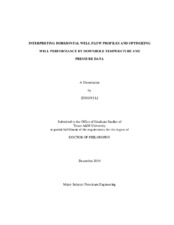| dc.description.abstract | Horizontal well temperature and pressure distributions can be measured by production
logging or downhole permanent sensors, such as fiber optic distributed temperature
sensors (DTS). Correct interpretation of temperature and pressure data can be used to
obtain downhole flow conditions, which is key information to control and optimize
horizontal well production. However, the fluid flow in the reservoir is often multiphase
and complex, which makes temperature and pressure interpretation very difficult. In
addition, the continuous measurement provides transient temperature behavior which
increases the complexity of the problem. To interpret these measured data correctly, a
comprehensive model is required.
In this study, an interpretation model is developed to predict flow profile of a
horizontal well from downhole temperature and pressure measurement. The model
consists of a wellbore model and a reservoir model. The reservoir model can handle
transient, multiphase flow and it includes a flow model and a thermal model. The
calculation of the reservoir flow model is based on the streamline simulation and the calculation of reservoir thermal model is based on the finite difference method. The
reservoir thermal model includes thermal expansion and viscous dissipation heating
which can reflect small temperature changes caused by pressure difference. We combine
the reservoir model with a horizontal well flow and temperature model as the forward
model. Based on this forward model, by making the forward calculated temperature and
pressure match the observed data, we can inverse temperature and pressure data to
downhole flow rate profiles. Two commonly used inversion methods, Levenberg-
Marquardt method and Marcov chain Monte Carlo method, are discussed in the study.
Field applications illustrate the feasibility of using this model to interpret the field
measured data and assist production optimization.
The reservoir model also reveals the relationship between temperature behavior
and reservoir permeability characteristic. The measured temperature information can
help us to characterize a reservoir when the reservoir modeling is done only with limited
information. The transient temperature information can be used in horizontal well
optimization by controlling the flow rate until favorite temperature distribution is
achieved. With temperature feedback and inflow control valves (ICVs), we developed a
procedure of using DTS data to optimize horizontal well performance. The synthetic
examples show that this method is useful at a certain level of temperature resolution and
data noise. | en |


